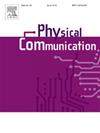Soft Actor–Critic optimization for efficient NOMA uplink in intelligent vehicular networks
IF 2
4区 计算机科学
Q3 ENGINEERING, ELECTRICAL & ELECTRONIC
引用次数: 0
Abstract
This paper addresses the need for efficient data transmission in congested intelligent vehicular networks using Non-Orthogonal Multiple Access (NOMA). We present a novel uplink communication model that maximizes NOMA’s spectral efficiency, enabling multiple vehicles to share frequency channels effectively. Our dynamic optimization framework adjusts channel assignments, power levels, and bandwidth allocations, significantly enhancing spectral and energy efficiencies critical for battery-limited intelligent vehicles. To address complex optimization challenges, we develop a Heterogeneous-action Multi-agent Soft Actor–Critic (HMSAC) algorithm with an enhanced attention mechanism, improving learning efficiency and convergence speed. Rigorous simulations show that our approach notably boosts energy efficiency, reliability, and scalability compared to baseline models. Finally, the challenges with NOMA implementation in dense networks and propose future research directions are also discussed.
求助全文
约1分钟内获得全文
求助全文
来源期刊

Physical Communication
ENGINEERING, ELECTRICAL & ELECTRONICTELECO-TELECOMMUNICATIONS
CiteScore
5.00
自引率
9.10%
发文量
212
审稿时长
55 days
期刊介绍:
PHYCOM: Physical Communication is an international and archival journal providing complete coverage of all topics of interest to those involved in all aspects of physical layer communications. Theoretical research contributions presenting new techniques, concepts or analyses, applied contributions reporting on experiences and experiments, and tutorials are published.
Topics of interest include but are not limited to:
Physical layer issues of Wireless Local Area Networks, WiMAX, Wireless Mesh Networks, Sensor and Ad Hoc Networks, PCS Systems; Radio access protocols and algorithms for the physical layer; Spread Spectrum Communications; Channel Modeling; Detection and Estimation; Modulation and Coding; Multiplexing and Carrier Techniques; Broadband Wireless Communications; Wireless Personal Communications; Multi-user Detection; Signal Separation and Interference rejection: Multimedia Communications over Wireless; DSP Applications to Wireless Systems; Experimental and Prototype Results; Multiple Access Techniques; Space-time Processing; Synchronization Techniques; Error Control Techniques; Cryptography; Software Radios; Tracking; Resource Allocation and Inference Management; Multi-rate and Multi-carrier Communications; Cross layer Design and Optimization; Propagation and Channel Characterization; OFDM Systems; MIMO Systems; Ultra-Wideband Communications; Cognitive Radio System Architectures; Platforms and Hardware Implementations for the Support of Cognitive, Radio Systems; Cognitive Radio Resource Management and Dynamic Spectrum Sharing.
 求助内容:
求助内容: 应助结果提醒方式:
应助结果提醒方式:


